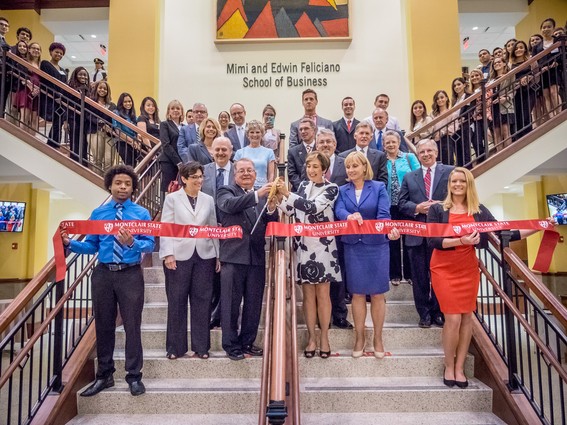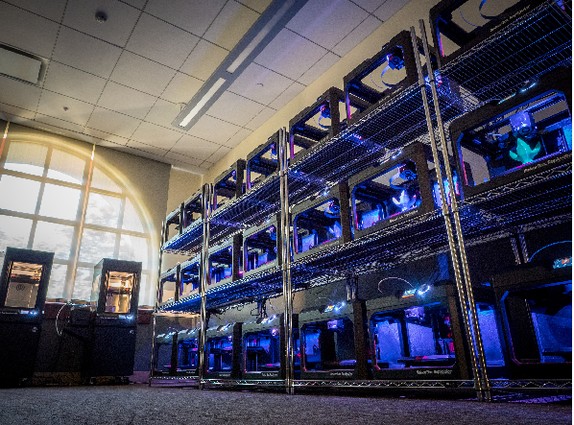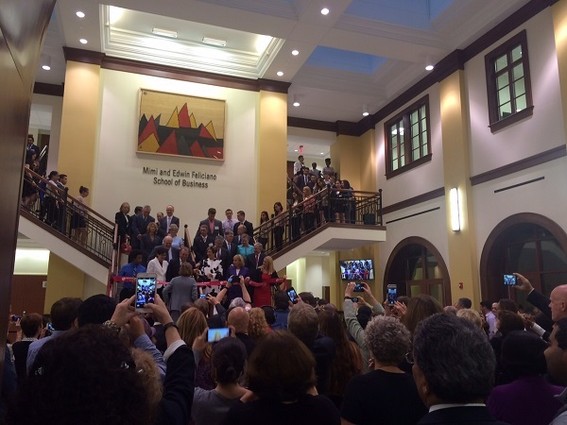Montclair University’s New Mimi and Edwin Feliciano School of Business Steeped in Technology

To thunderous applause, Montclair State University cut the ribbon on the Mimi and Edwin Feliciano School of Business on Sept. 10. The impressive structure was built in part with funding from the state’s Building Our Future Bond Act and a generous contribution by Mimi and Edwin Feliciano.
Montclair State President Susan Cole discussed the many attributes of the beautiful building, including those that will help the Feliciano Center for Entrepreneurship, headed by Dennis Bone, to thrive.
Other dignitaries, including New Jersey’s Lt. Governor Kim Guadagno and benefactors Mimi and Edwin Feliciano, spoke to the invited guests, who filled a cavernous room at the foot of the staircase.
While the $66 million, six-story, 143,000-square-foot building isn’t a technology center, it is steeped in technology.
“We are the first in New Jersey to have an Innovation Center,” said Roger Salomon, director of instructional services and technology at the business school, in a recent interview.

The Innovation Center is a lab where some 35 MakerBot printers and scanners reside. These are currently being used in the Feliciano Center for Entrepreneurship, where students work on ideas for new enterprises.
“We have about 23 Replicators and three Z18s that are truly networked printers, with another set of X2 and Mini printers,” said Salomon, who added that the program is open to all students at the university, in an attempt to diversify both ideas and entrepreneurship.
This is the university’s first attempt at using 3D printers on this scale, he noted, although the business school had piloted a single 3D printer last year, “with some pretty good success.” The lab has already become so popular that Montclair State hired a full-time instructional specialist to help develop the curriculum and facilitate the center’s activities.
The students are excited about the lab, said Salomon, and the faculty has begun to use it for their projects as well.
Salomon explained that students or faculty who want to have something printed will design their end-product using 3D printing software from either Google or MakerBot. They work on their projects remotely and then send the completed “print job” to the lab.
Once sent, they wait for approval from the lab’s faculty advisor, who will make sure the item is structurally sound, so that it won’t fall apart when it’s built. Part of the curriculum, Salomon explained, is understanding how to develop a product that will stand up to being built with a 3D printer.
The new business school building also incorporates a financial resource room with six Bloomberg terminals used by students for projects and research. “Bloomberg is the gold standard for finding financial, market and management data — and everything in between,” Salomon said.
Right across the hall from the resource center is a trading floor where students use financial applications such as StockTrak. Students can use this software to develop, among other things, their own mock portfolio of stocks and see how it performs. The School of Business has been given some seed money to enable students to use actual funds to develop their own financial portfolios, he added.
The new School of Business building is fully wireless and has a Virtual Desktop Infrastructure (VDI) environment. All of the computer labs use virtual desktops, as opposed to having a full-blown CPU at each station.

“There are several reasons why we went with virtual desktops,” Salomon said. “Individual PCs are difficult to manage easily as a collective. Our virtual desktop environment, using VMware, has made managing, updating and patching nearly 200 endpoints easier and more efficient. No longer do we need to service computers one by one.”
“In the early days of VDI, server horsepower was very expensive, and our ability to offer a similar or better desktop experience to our users on stand-alone desktops was quite expensive,” he explained. “VMWare has greatly improved the server and desktop systems, leveraging more effective server back-end systems, in our case an HP 3PAR array, and deploying a much-improved software package, making our current eco-system a highly effective one.”
“All of our administrative support staff and computer labs are on virtual desktops through local zero and thin clients,” he said. “Eventually, our graduate assistants and adjunct suites will have virtual desktops,” as soon as the school can roll them out, which should be by the end of the year.
There are 19 group study rooms on campus, and they are booked solid, according to Salomon. Students are using touch panels from Crestron Electronics (Rockleigh) to schedule the rooms.
“Our lecture hall is a beautiful 150-seat space, and is one of six spaces in the building that incorporates lecture-capture and video-conferencing capabilities, which is great for connecting with corporate partners and storing our interactions for posterity,” he said.

